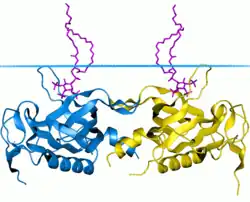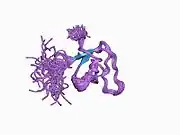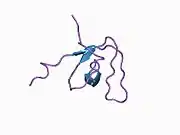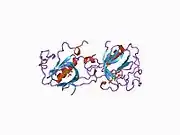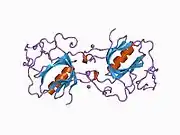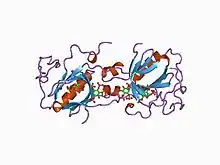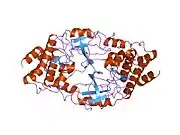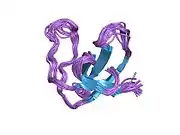Bruton's tyrosine kinase
Bruton's tyrosine kinase (abbreviated Btk or BTK), also known as tyrosine-protein kinase BTK, is a tyrosine kinase that is encoded by the BTK gene in humans. BTK plays a crucial role in B cell development.
Structure
BTK contains five different protein interaction domains. These domains include an amino terminal pleckstrin homology (PH) domain, a proline-rich TEC homology (TH) domain, SRC homology (SH) domains SH2 and SH3, as well as a kinase domain with enzymatic activity.[5]

Function
BTK plays a crucial role in B cell development as it is required for transmitting signals from the pre-B cell receptor that forms after successful immunoglobulin heavy chain rearrangement.[6] It also has a role in mast cell activation through the high-affinity IgE receptor.[7]
Btk contains a PH domain that binds phosphatidylinositol (3,4,5)-trisphosphate (PIP3). PIP3 binding induces Btk to phosphorylate phospholipase C, which in turn hydrolyzes PIP2, a phosphatidylinositol, into two second messengers, inositol triphosphate (IP3) and diacylglycerol (DAG), which then go on to modulate the activity of downstream proteins during B-cell signalling.
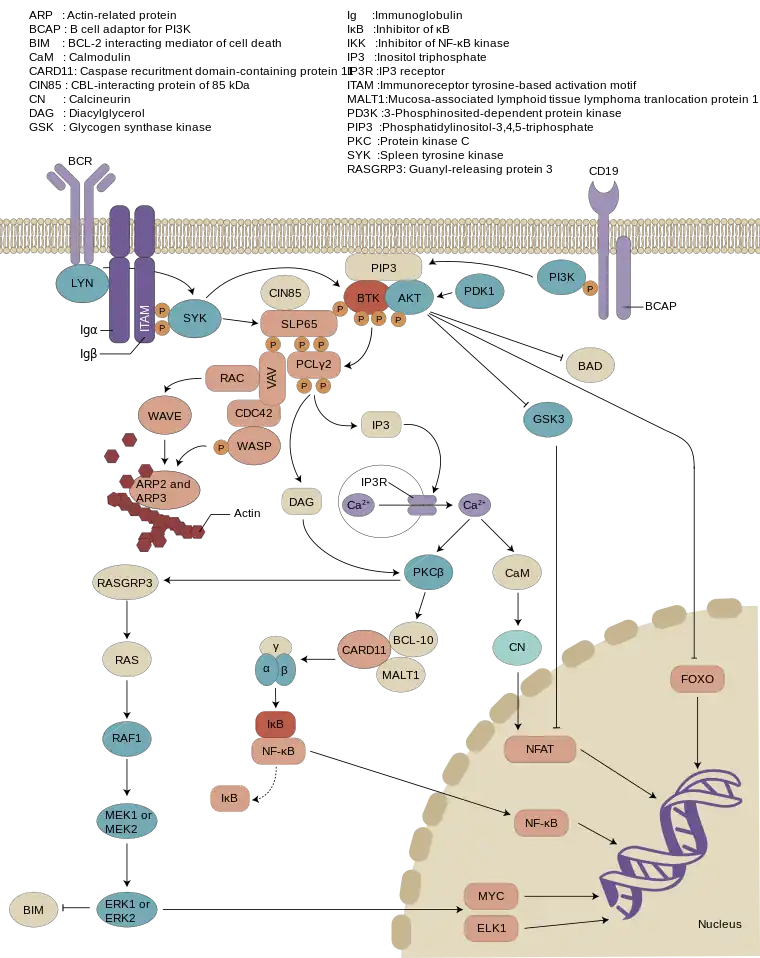
Clinical significance
Mutations in the BTK gene are implicated in the primary immunodeficiency disease X-linked agammaglobulinemia (Bruton's agammaglobulinemia); sometimes abbreviated to XLA and selective IgM deficiency.[8] Patients with XLA have normal pre-B cell populations in their bone marrow but these cells fail to mature and enter the circulation. The Btk gene is located on the X chromosome (Xq21.3-q22).[9] At least 400 mutations of the BTK gene have been identified. Of these, at least 212 are considered to be disease-causing mutations.[10]
BTK inhibitors
Approved drugs that inhibit BTK:
- Ibrutinib (Imbruvica), a selective Bruton's tyrosine kinase inhibitor.
- Acalabrutinib (Calquence), approved in October 2017[11] for relapsed mantle cell lymphoma.
- Zanubrutinib (Brukinsa) for mantle cell lymphoma, chronic lymphocytic leukemia, or small lymphocytic lymphoma.[12] It can be taken by mouth.[13][14]
- Tirabrutinib (Velexbru), approved in March 2020, in Japan, for the treatment of recurrent or refractory primary central nervous system lymphoma.[15]
- Pirtobrutinib (Jaypirca), a reversible (non-covalent) inhibitor of BTK, for mantle cell lymphoma.[16][17]
Various drugs that inhibit BTK are in clinical trials:[18]
- Phase 3:
- Acalabrutinib, for relapsed chronic lymphocytic leukemia (CLL), 95% overall remission reported.
- Evobrutinib for multiple sclerosis.[19][20][21]
- Tolebrutinib, for multiple sclerosis.[22][23]
- Remibrutinib, for multiple sclerosis.[24]
- Fenebrutinib (RG7845) for multiple sclerosis.[25][26]
- Phase 2:
- Phase 1:
- ONO-4059 for non-Hodgkin lymphoma and/or CLL.[29] Renamed GS-4059 and now in trial NCT02457598.[30]
- Spebrutinib (AVL-292, CC-292) [31]
- HM71224 for autoimmune diseases, under development by Hanmi Pharmaceutical and Lilly as of 2015[32]
Discovery
Bruton's tyrosine kinase was discovered in 1993 and is named for Ogden Bruton, who first described XLA in 1952.[9]
Interactions
Bruton's tyrosine kinase has been shown to interact with:
References
- GRCh38: Ensembl release 89: ENSG00000010671 - Ensembl, May 2017
- GRCm38: Ensembl release 89: ENSMUSG00000031264 - Ensembl, May 2017
- "Human PubMed Reference:". National Center for Biotechnology Information, U.S. National Library of Medicine.
- "Mouse PubMed Reference:". National Center for Biotechnology Information, U.S. National Library of Medicine.
- Pal Singh S, Dammeijer F, Hendriks RW (February 2018). "Role of Bruton's tyrosine kinase in B cells and malignancies". Molecular Cancer. 17 (1): 57. doi:10.1186/s12943-018-0779-z. PMC 5817726. PMID 29455639.
- Owen JA, Punt J, Stranford SA, Jones PP (2013). Kuby Immunology (7th ed.). New York: W.H. Freeman. p. 93. ISBN 978-14641-3784-6.
- Turner H, Kinet JP (November 1999). "Signalling through the high-affinity IgE receptor Fc epsilonRI". Nature. 402 (6760 Suppl): B24–B30. doi:10.1038/35037021. PMID 10586892.
- Geier CB, Sauerwein KM, Leiss-Piller A, Zmek I, Fischer MB, Eibl MM, Wolf HM (18 August 2018). "Hypomorphic Mutations in the BCR Signalosome Lead to Selective Immunoglobulin M Deficiency and Impaired B-cell Homeostasis". Frontiers in Immunology. 9: 2984. doi:10.3389/fimmu.2018.02984. PMC 6305442. PMID 30619340.
- X-Linked Agammaglobulinemia Patient and Family Handbook for The Primary Immune Diseases. Third Edition. 2001. Published by the Immune Deficiency Foundation.
- Šimčíková D, Heneberg P (December 2019). "Refinement of evolutionary medicine predictions based on clinical evidence for the manifestations of Mendelian diseases". Scientific Reports. 9 (1): 18577. Bibcode:2019NatSR...918577S. doi:10.1038/s41598-019-54976-4. PMC 6901466. PMID 31819097.
- "FDA approves new treatment for adults with mantle cell lymphoma". Food and Drug Administration. 24 March 2020.
- "FDA approves therapy to treat patients with relapsed and refractory mantle cell lymphoma supported by clinical trial results showing high response rate of tumor shrinkage". U.S. Food and Drug Administration (FDA) (Press release). 14 November 2019. Retrieved 15 November 2019.
- BeiGene Announces Initiation of a Combination Trial of the BTK Inhibitor BGB-3111 with the PD-1 Antibody BGB-A317. June 2016
- "FDA approves zanubrutinib for chronic lymphocytic leukemia or small lymphocytic lymphoma". U.S. Food and Drug Administration (FDA). 19 January 2023. Retrieved 26 January 2023.
- Dhillon S (June 2020). "Tirabrutinib: First Approval". Drugs. 80 (8): 835–840. doi:10.1007/s40265-020-01318-8. PMID 32382949. S2CID 218531327.
- "FDA grants accelerated approval to pirtobrutinib for relapsed or refractory mantle cell lymphoma". U.S. Food and Drug Administration (FDA). 27 January 2023.
- Mato AR, Shah NN, Jurczak W, Cheah CY, Pagel JM, Woyach JA, et al. (March 2021). "Pirtobrutinib in relapsed or refractory B-cell malignancies (BRUIN): a phase 1/2 study". Lancet. 397 (10277): 892–901. doi:10.1016/S0140-6736(21)00224-5. PMID 33676628. S2CID 232116910.
- Alu A, Lei H, Han X, Wei Y, Wei X (October 2022). "BTK inhibitors in the treatment of hematological malignancies and inflammatory diseases: mechanisms and clinical studies". Journal of Hematology & Oncology. 15 (1): 138. doi:10.1186/s13045-022-01353-w. PMC 9526392. PMID 36183125.
- Montalban X, Arnold DL, Weber MS, Staikov I, Piasecka-Stryczynska K, Willmer J, et al. (June 2019). "Placebo-Controlled Trial of an Oral BTK Inhibitor in Multiple Sclerosis". The New England Journal of Medicine. 380 (25): 2406–2417. doi:10.1056/NEJMoa1901981. PMID 31075187.
- Clinical trial number NCT02975349 for "A Study of Efficacy and Safety of M2951 in Subjects With Relapsing Multiple Sclerosis" at ClinicalTrials.gov
- Clinical trial number NCT04032171 for "A Phase III, Multicenter, Randomized, Parallel Group, Double Blind, Double Dummy, Active Controlled Study of Evobrutinib Compared With an Interferon Beta 1a (Avonex®), in Participants With RMS to Evaluate Efficacy and Safety " at ClinicalTrials.gov
- Dolgin E (January 2021). "BTK blockers make headway in multiple sclerosis". Nature Biotechnology. 39 (1): 3–5. doi:10.1038/s41587-020-00790-7. PMID 33432223.
- Clinical trial number NCT04742400 for "A Phase 2 Clinical Trial of Tolebrutinib, a Brain-penetrant Bruton s Tyrosine Kinase Inhibitor, for the Modulation of Chronically Inflamed White Matter Lesions in Multiple Sclerosis" at ClinicalTrials.gov
- Wexler M (21 June 2022). "Remibrutinib for Multiple Sclerosis". BioNews, Inc.
- "Genentech: Our Pipeline". www.gene.com. Retrieved 5 June 2023.
- Hoffmann-La Roche (30 May 2023). "A Phase III Multicenter, Randomized, Double-Blind, Double-Dummy, Parallel-Group Study to Evaluate the Efficacy and Safety of Fenebrutinib Compared With Ocrelizumab in Adult Patients With Primary Progressive Multiple Sclerosis".
{{cite journal}}: Cite journal requires|journal=(help) - Clinical trial number NCT03978520 for "A Study to Investigate the Safety and Efficacy of ABBV-105 and Upadacitinib Given Alone or in Combination in Participants With Moderately to Severely Active Systemic Lupus Erythematosus - Full Text View - ClinicalTrials.gov" at ClinicalTrials.gov
- "Genentech: Our Pipeline". www.gene.com. Retrieved 10 October 2020.
- Clinical trial number NCT01659255 for "ONO-4059 Phase I Dose-escalation Study to Investigate the Safety and Tolerability of ONO-4059 Given as Monotherapy in Patients With Relapsed/Refractory Non-Hodgkin's Lymphoma and/or Chronic Lymphocytic Leukaemi" at ClinicalTrials.gov
- "Novel BTK, PI3K Inhibitors on Horizon for Relapsed CLL. March 2016". Archived from the original on 5 April 2016. Retrieved 22 March 2016.
- Clinical trial number NCT01351935 for "Escalating Dose Study in Subjects With Relapsed or Refractory B Cell Non-Hodgkin Lymphoma, Chronic Lymphocytic Leukemia, and Waldenstrom's Macroglobulinemia" at ClinicalTrials.gov
- Garde D (19 March 2015). "Lilly inks a $690M deal to get its hands on an autoimmune drug". FierceBiotech.
- Nixon JC, Rajaiya JB, Ayers N, Evetts S, Webb CF (March 2004). "The transcription factor, Bright, is not expressed in all human B lymphocyte subpopulations". Cellular Immunology. 228 (1): 42–53. doi:10.1016/j.cellimm.2004.03.004. PMID 15203319.
- Yasuda T, Tezuka T, Maeda A, Inazu T, Yamanashi Y, Gu H, et al. (July 2002). "Cbl-b positively regulates Btk-mediated activation of phospholipase C-gamma2 in B cells". The Journal of Experimental Medicine. 196 (1): 51–63. doi:10.1084/jem.20020068. PMC 2194016. PMID 12093870.
- Hashimoto S, Iwamatsu A, Ishiai M, Okawa K, Yamadori T, Matsushita M, et al. (October 1999). "Identification of the SH2 domain binding protein of Bruton's tyrosine kinase as BLNK--functional significance of Btk-SH2 domain in B-cell antigen receptor-coupled calcium signaling". Blood. 94 (7): 2357–2364. doi:10.1182/blood.V94.7.2357.419k40_2357_2364. PMID 10498607. S2CID 21014231.
- Vargas L, Nore BF, Berglof A, Heinonen JE, Mattsson PT, Smith CI, Mohamed AJ (March 2002). "Functional interaction of caveolin-1 with Bruton's tyrosine kinase and Bmx". The Journal of Biological Chemistry. 277 (11): 9351–9357. doi:10.1074/jbc.M108537200. PMID 11751885.
- Ma YC, Huang XY (October 1998). "Identification of the binding site for Gqalpha on its effector Bruton's tyrosine kinase". Proceedings of the National Academy of Sciences of the United States of America. 95 (21): 12197–12201. Bibcode:1998PNAS...9512197M. doi:10.1073/pnas.95.21.12197. PMC 22808. PMID 9770463.
- Sacristán C, Tussié-Luna MI, Logan SM, Roy AL (February 2004). "Mechanism of Bruton's tyrosine kinase-mediated recruitment and regulation of TFII-I". The Journal of Biological Chemistry. 279 (8): 7147–7158. doi:10.1074/jbc.M303724200. PMID 14623887.
- Novina CD, Kumar S, Bajpai U, Cheriyath V, Zhang K, Pillai S, et al. (July 1999). "Regulation of nuclear localization and transcriptional activity of TFII-I by Bruton's tyrosine kinase". Molecular and Cellular Biology. 19 (7): 5014–5024. doi:10.1128/mcb.19.7.5014. PMC 84330. PMID 10373551.
- Yang W, Desiderio S (January 1997). "BAP-135, a target for Bruton's tyrosine kinase in response to B cell receptor engagement". Proceedings of the National Academy of Sciences of the United States of America. 94 (2): 604–609. Bibcode:1997PNAS...94..604Y. doi:10.1073/pnas.94.2.604. PMC 19560. PMID 9012831.
- Guo B, Kato RM, Garcia-Lloret M, Wahl MI, Rawlings DJ (August 2000). "Engagement of the human pre-B cell receptor generates a lipid raft-dependent calcium signaling complex". Immunity. 13 (2): 243–253. doi:10.1016/s1074-7613(00)00024-8. PMID 10981967.
- Johannes FJ, Hausser A, Storz P, Truckenmüller L, Link G, Kawakami T, Pfizenmaier K (November 1999). "Bruton's tyrosine kinase (Btk) associates with protein kinase C mu". FEBS Letters. 461 (1–2): 68–72. doi:10.1016/S0014-5793(99)01424-6. PMID 10561498. S2CID 86153017.
- Matsushita M, Yamadori T, Kato S, Takemoto Y, Inazawa J, Baba Y, et al. (April 1998). "Identification and characterization of a novel SH3-domain binding protein, Sab, which preferentially associates with Bruton's tyrosine kinase (BtK)". Biochemical and Biophysical Research Communications. 245 (2): 337–343. doi:10.1006/bbrc.1998.8420. PMID 9571151.
- Yamadori T, Baba Y, Matsushita M, Hashimoto S, Kurosaki M, Kurosaki T, et al. (May 1999). "Bruton's tyrosine kinase activity is negatively regulated by Sab, the Btk-SH3 domain-binding protein". Proceedings of the National Academy of Sciences of the United States of America. 96 (11): 6341–6346. Bibcode:1999PNAS...96.6341Y. doi:10.1073/pnas.96.11.6341. PMC 26883. PMID 10339589.
Further reading
- Ochs HD, Aruffo A (December 1993). "Advances in X-linked immunodeficiency diseases". Current Opinion in Pediatrics. 5 (6): 684–691. doi:10.1097/00008480-199312000-00008. PMID 7907259.
- Uckun FM (September 1998). "Bruton's tyrosine kinase (BTK) as a dual-function regulator of apoptosis". Biochemical Pharmacology. 56 (6): 683–691. doi:10.1016/S0006-2952(98)00122-1. PMID 9751072.
- Tsubata T, Wienands J (2001). "B cell signaling. Introduction". International Reviews of Immunology. 20 (6): 675–678. doi:10.3109/08830180109045584. PMID 11913944. S2CID 218878743.
- Etzioni A (April 2002). "Novel aspects of hypogammaglobulinemic states". The Israel Medical Association Journal. 4 (4): 294–297. PMID 12001708.
- Niiro H, Clark EA (November 2003). "Branches of the B cell antigen receptor pathway are directed by protein conduits Bam32 and Carma1". Immunity. 19 (5): 637–640. doi:10.1016/S1074-7613(03)00303-0. PMID 14614850.
- Carpenter CL (April 2004). "Btk-dependent regulation of phosphoinositide synthesis". Biochemical Society Transactions. 32 (Pt 2): 326–329. doi:10.1042/BST0320326. PMID 15046600. S2CID 41318916.
- Hendriks RW, Kersseboom R (February 2006). "Involvement of SLP-65 and Btk in tumor suppression and malignant transformation of pre-B cells". Seminars in Immunology. 18 (1): 67–76. doi:10.1016/j.smim.2005.10.002. PMID 16300960.
External links
- GeneReviews/NCBI/NIH/UW entry on X-Linked or Brunton's Agammaglobulinemia
- Bruton's+tyrosine+kinase at the U.S. National Library of Medicine Medical Subject Headings (MeSH)
- Human BTK genome location and BTK gene details page in the UCSC Genome Browser.
- Overview of all the structural information available in the PDB for UniProt: Q06187 (Tyrosine-protein kinase BTK) at the PDBe-KB.
